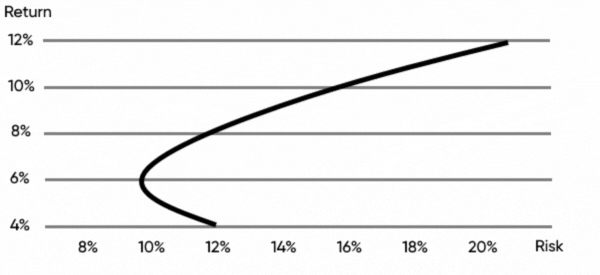
A COMMON SENSE APPROACH TO LOW FEE INDEXING
Everyone has short, medium and long-term expenses. The problem with investing is that these time horizons involve uncertainty because we do not know the time horizons over which certain instruments exist and protect us. For instance, cash gives us near-term certainty, but poor long-term certainty (because it earns a zero or low return). Stocks, on the other hand, gives us little near-term certainty, but greater long-term certainty (because they generate higher, but volatile long-term returns). Traditional portfolio management applies allocation models that account for risk per unit of return, but fail to account for the problem of time within this process. The Defined Duration Investing approach adds the element of time by quantifying a portfolio for returns per unit of risk across time.

This innovative approach to asset allocation helps improve the probability of meeting your financial goals by helping you better understand your liabilities and the way specific assets align with those liabilities. This not only establishes a financial planning based foundation, but it applies a behaviorally robust solution to the problems that exist in Modern Portfolio Theory.
Planning Based
Fully Customizable
Low Fee and Tax Efficient
All Weather
Behaviorally Robust


Traditional portfolio construction uses what’s called “mean variance optimization” or Modern Portfolio Theory. This means the portfolio manager plugs in a certain risk profile and then spits out an “efficient” asset allocation such as a 60/40 stock/bond portfolio. This approach is usually sold to investors as generating the optimal return per unit of risk in exchange for high fees. But this process is backwards and fails to provide the investor with an understanding of how much risk they’re taking per unit of return across time. This is because the portfolio manager is looking for the optimal assets without any understanding of the customer’s specific liabilities.
The Defined Duration strategy flips this entire process around and starts by first quantifying the liabilities. We then apply the proper assets based on liability needs, not based on asset performance wants. This financial planning based foundation gives the investor a better understanding of how much money they’ll have at certain times in their life thereby creating a diversified and behaviorally robust asset allocation.

We build custom portfolios to meet your planning needs, but as a general overview the Defined Duration portfolio has three specific buckets:
- Nominal stability bucket
- Growth bucket
- Insurance bucket

The specific portfolio will be implemented using low cost and tax efficient bonds and ETFs.
The nominal stability bucket is comprised of instruments that are designed to give you short-term principal stability and income to help you meet short-term and medium-term liability needs. This could include money market funds, Treasury Bills and bond ETFs and will generally comprise 10-30% of the portfolio depending on planning needs.
The growth bucket is comprised of diversified stock ETFs, REITs, corporate bond ETFs and multi-asset ETFs. This is the core of the portfolio and will be implemented in a tax efficient and diversified manner comprising 30-60% of the portfolio.
The insurance bucket is dynamic and changes across time to meet your portfolio’s insurance needs. This could include gold, options, commodities and other instruments that have low expected real returns and high potential asymmetric payoffs to help protect you from inflation and other uncertainties. It will fluctuate from 0-15% of the portfolio depending on macroeconomic conditions. The insurance bucket is highly customizable and optional for most investors.
Defined Duration Investing is a common sense approach to asset allocation using a dynamic asset allocation with a financial planning based foundation.
